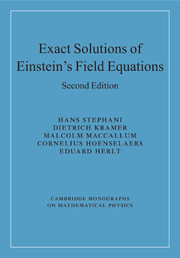Book contents
- Frontmatter
- Contents
- Preface
- List of tables
- Notation
- 1 Introduction
- Part I General methods
- 2 Differential geometry without a metric
- 3 Some topics in Riemannian geometry
- 4 The Petrov classification
- 5 Classification of the Ricci tensor and the energy-momentum tensor
- 6 Vector fields
- 7 The Newman–Penrose and related formalisms
- 8 Continuous groups of transformations; isometry and homothety groups
- 9 Invariants and the characterization of geometries
- 10 Generation techniques
- Part II Solutions with groups of motions
- Part III Algebraically special solutions
- Part IV Special methods
- Part V Tables
- References
- Index
9 - Invariants and the characterization of geometries
from Part I - General methods
Published online by Cambridge University Press: 10 November 2009
- Frontmatter
- Contents
- Preface
- List of tables
- Notation
- 1 Introduction
- Part I General methods
- 2 Differential geometry without a metric
- 3 Some topics in Riemannian geometry
- 4 The Petrov classification
- 5 Classification of the Ricci tensor and the energy-momentum tensor
- 6 Vector fields
- 7 The Newman–Penrose and related formalisms
- 8 Continuous groups of transformations; isometry and homothety groups
- 9 Invariants and the characterization of geometries
- 10 Generation techniques
- Part II Solutions with groups of motions
- Part III Algebraically special solutions
- Part IV Special methods
- Part V Tables
- References
- Index
Summary
When discussing solutions, we should often like to be able to decide, in an invariant manner, whether two metrics, each given in some specific coordinate system, are identical or not, or whether a given metric is new or not. For such purposes it is useful to have an invariantly-defined and unique complete characterization of each metric. Such a characterization can be attempted using scalar polynomial invariants, whose definition and construction are discussed in §9.1. However, it turns out that those invariants do not characterize space-times uniquely.
A method which does provide a unique coordinate-independent characterization, using Cartan invariants, is described in §9.2. This enables one to compare metrics given in differing coordinate systems, which distinguishes the results from those on uniqueness of the metric given the coordinate components for curvature and its derivatives (for which see e.g. Ihrig (1975), Hall and Kay (1988)). That uniqueness is related to the structure of the holonomy group, defined for each point p as the group of linear transformations of the tangent space at p generated by the holonomy (see §2.10) for different closed curves, or of the infinitesimal holonomy group, which is generated by the curvature and its derivatives but is equal to the holonomy group at almost all points in simply-connected smooth manifolds. These groups are subgroups of the Lorentz group and their properties can also be related to classification of curvature and the existence of constant tensor fields (Goldberg and Kerr 1961, Beiglböck 1964, Ihrig 1975, Hall 1991).
Information
- Type
- Chapter
- Information
- Exact Solutions of Einstein's Field Equations , pp. 112 - 128Publisher: Cambridge University PressPrint publication year: 2003
